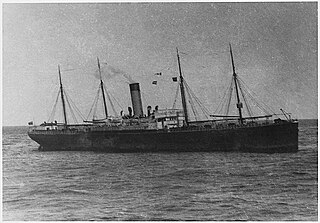
SS Californian was a British Leyland Line steamship. She is thought to have been the only ship to see the Titanic, or at least her rockets, during the sinking, but despite being the closest ship in the area, the crew took no action to assist. The United States Senate inquiry and British Wreck Commissioner's inquiry into the sinking both concluded that the Californian could have saved many or all of the lives that were lost, had a prompt response been mounted to the Titanic's distress rockets. The U.S. Senate inquiry was particularly critical of the vessel's captain, Stanley Lord, calling his inaction during the disaster "reprehensible".

Edward John Smith was a British sea captain and naval officer. In 1880, he joined the White Star Line as an officer, beginning a long career in the British Merchant Navy. Smith went on to serve as the master of numerous White Star Line vessels. During the Second Boer War, he served in the Royal Naval Reserve, transporting British Imperial troops to the Cape Colony. Smith served as captain of the ocean liner Titanic, and went down with the ship when she sank on her maiden voyage.

William Alden Smith was a U.S. Representative and U.S. Senator from the state of Michigan. After the 1912 sinking of the Titanic, Smith chaired the Senate hearings into the disaster. His report led to major reforms in maritime safety.

Joseph Bruce Ismay was an English businessman who served as chairman and managing director of the White Star Line. In 1912, he came to international attention as the highest-ranking White Star official to survive the sinking of the company's new flagship RMS Titanic, for which he was subject to severe criticism.
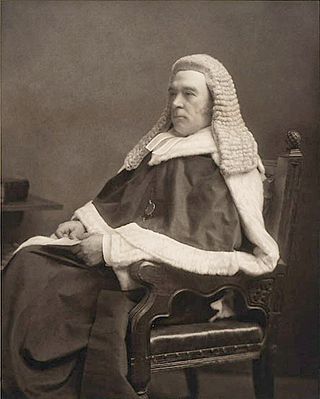
John Charles Bigham, 1st Viscount Mersey, was a British jurist and politician. After early success as a lawyer and a less successful spell as a politician, he was appointed a judge and worked in commercial law.

Malcolm Tierney was an English actor who appeared in many stage, film and television roles.
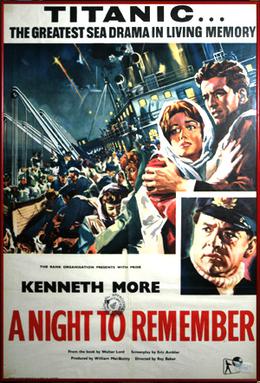
A Night to Remember is a 1958 British historical disaster docudrama film based on the eponymous 1955 book by Walter Lord, and depicts the final night of RMS Titanic, which sank on her maiden voyage after striking an iceberg in 1912. Adapted by Eric Ambler and directed by Roy Ward Baker, the film stars Kenneth More as the ship's Second Officer Charles Lightoller and features Michael Goodliffe, Laurence Naismith, Kenneth Griffith, David McCallum and Tucker McGuire. It was filmed in the United Kingdom and tells the story of the sinking, portraying incidents and people in a documentary-style fashion with considerable attention to detail. The production team, supervised by producer William MacQuitty used blueprints of the ship to create authentic sets, while Fourth Officer Joseph Boxhall and ex-Cunard Commodore Harry Grattidge worked as technical advisors on the film. Its estimated budget of up to £600,000 was exceptional and made it the most expensive film ever made in Britain up to that time. The film's score was written by William Alwyn.

Harold Thomas Cottam was a British wireless operator on the RMS Carpathia who fortuitously happened to receive the distress call from the sinking RMS Titanic on 15 April 1912. Cottam's decision to awaken Captain Arthur Henry Rostron and relay Titanic's message in spite of the scepticism of the officer on watch allowed Carpathia to arrive at the scene hours before any other ship and is "credited with saving hundreds of lives." He was a personal friend of the Titanic's wireless operators Harold Bride and Jack Phillips.

The Titanic has played a prominent role in popular culture since her sinking in 1912, with the loss of over 1,500 of the 2,200 lives on board. The disaster and the Titanic herself have been objects of public fascination for many years. They have inspired numerous books, plays, films, songs, poems, and works of art. The story has been interpreted in many overlapping ways, including as a symbol of technological hubris, as basis for fail-safe improvements, as a classic disaster tale, as an indictment of the class divisions of the time, and as romantic tragedies with personal heroism. It has inspired many moral, social and political metaphors and is regularly invoked as a cautionary tale of the limitations of modernity and ambition.
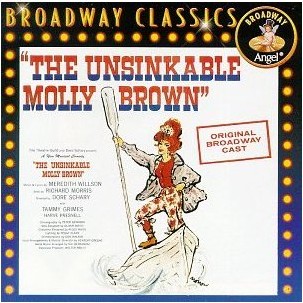
The Unsinkable Molly Brown is a 1960 musical with music and lyrics by Meredith Willson and book by Richard Morris. The plot is a fictionalized account of the life of Margaret Brown, who survived the sinking of the RMS Titanic, and her wealthy miner-husband. A musical film version, also titled The Unsinkable Molly Brown, with screenplay by Helen Deutsch, was released in 1964.
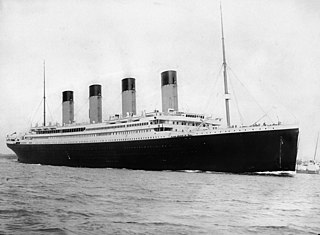
RMS Titanic was a British ocean liner that sank on 15 April 1912 after striking an iceberg on the ship's maiden voyage from Southampton, England to New York City, United States. Of the estimated 2,224 passengers and crew aboard, approximately 1,500 died, making the incident the deadliest sinking of a single ship at the time. Titanic, operated by the White Star Line, carried some of the wealthiest people in the world, as well as hundreds of emigrants from the British Isles, Scandinavia, and elsewhere in Europe who were seeking a new life in the United States and Canada. The disaster drew public attention, spurred major changes in maritime safety regulations, and inspired a lasting legacy in popular culture.

There have been several legends and myths surrounding the RMS Titanic and its destruction after colliding with an iceberg in the Atlantic Ocean. These have ranged from stories involving the myth about the ship having been described as "unsinkable" to the myth concerning the final song played by the ship's musicians.

Titanic Lifeboat No. 1 was a lifeboat from the steamship Titanic. It was the fifth boat launched to sea, over an hour after the liner collided with an iceberg and began sinking on 14 April 1912. With a capacity of 40 people, it was launched with only 12 aboard, the fewest to escape in any one boat that night.

The sinking of the RMS Titanic on April 14–15, 1912 resulted in an inquiry by a subcommittee of the Commerce Committee of the United States Senate, chaired by Senator William Alden Smith. The hearings began in New York on April 19, 1912, later moving to Washington, D.C., concluding on May 25, 1912 with a return visit to New York.

The sinking of the RMS Titanic on 15 April 1912 resulted in an inquiry by the British Wreck Commissioner on behalf of the British Board of Trade. The inquiry was overseen by High Court judge Lord Mersey, and was held in London from 2 May to 3 July 1912. The hearings took place mainly at the London Scottish Drill Hall, at 59 Buckingham Gate, London SW1.
The ocean liner Titanic has been extensively portrayed in films, books, memorials and museums.

Dickinson H. Bishop was an American businessman who traveled on board the ill-fated maiden voyage of the RMS Titanic while on his honeymoon with bride Helen, née Walton. They both survived the sinking of the Titanic on 15 April 1912.

Frederick William Barrett was a British stoker. After having served as a stoker on several ships, on 6 April 1912, he was hired on board the RMS Titanic as lead stoker. On April 15, 1912, while the ship was sinking, Barrett boarded lifeboat No. 13 and took command of it, thus surviving the disaster. He later testified before commissions of inquiry into the sinking of the ship and continued to work in the navy until the 1920s. In 1923, after losing his wife Mary Anne Jones, he remained in Liverpool and worked ashore as a logger.

Robert Douglas Spedden was a child survivor of the sinking of the RMS Titanic. After surviving the sinking, his mother Daisy Spedden wrote the book Polar the Titanic Bear for him. Spedden died three years after the sinking, when he was hit by an automobile.
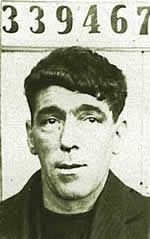
Frank Oliver Evans was a British Able Seaman of the RMS Titanic as part of its Deck Crew. He was known for being a survivor of the ship as well as being one of 18 crew members of the lifeboat drill.


















